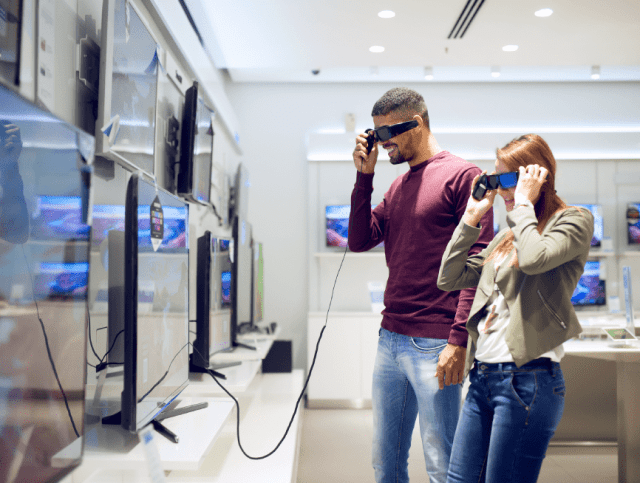We have reached “peak stuff.” You might have heard of this notion coined by IKEA’s CSO wherein financially stable consumers don’t have a need for anything more than what they already have. Pair this with many eCommerce brands competing for attention in a congested market, while physical stores work hard to stay relevant in the digital revolution — omnichannel retailers are left with a tall order to not only effectively reach target consumer audiences, but earn their loyalty as well.
Despite headlines of legacy retailers shuttering store locations, the death of the physical storefront is neither imminent nor wise. Retailers should prioritize the customer experience in stores by creating memorable interactions with brands. Retail marketers are realizing more and more how experiential retail can act as a unique extension of eCommerce, offering an aspect of entertainment: “retailtainment” if you will. But what is retailtainment? It enriches the shopper’s relationship with the brand and entices long-term loyalty. Large retail brands are already hopping on this train as evidenced by Macy’s Story stores offering yoga classes and cooking workshops or when Barneys New York launched its spring campaign alongside a virtual reality experience.
Let’s dive into the ways in which retail marketers can help build loyalty and boost eCommerce sales through retail experiences:
Maximize physical storefronts to support eCommerce
Having a physical store location doesn’t necessarily mean it has to be a space only reserved for POS interactions. For example, Nordstrom’s merchandise-less experience store Nordstrom Local didn’t allow shoppers to buy a single item in person; they were required to purchase online later. With eCommerce consistently on the rise —sales grew 16% in 2017 — retail marketers can use offline experiences in stores geared toward events or demonstrations to incentivize online sales. Retail experience stores can provide a sense of urgency and interest traditional retail spaces cannot. For example, a footwear retailer could invite customers to an in-store event centered around a new sneaker launch, and encourage attendees to pre-order their shoes on the web site using a special code or offer tablets to place the online order while at the event. Customers will feel a level of exclusivity as well as a sense of urgency to get the deal.
Understanding the Retailtainment Meaning
As brands continue to blend entertainment with shopping experiences, it’s important to define the retailtainment meaning more precisely. Retailtainment refers to the strategic use of entertainment elements—such as events, performances, workshops, or immersive technology—to enhance the retail experience and deepen emotional connections with customers. This concept goes beyond traditional marketing by turning stores into destinations where customers enjoy memorable moments, not just transactions. Some of the best retailtainment examples include Nike’s interactive flagship stores with basketball courts, Apple’s Today at Apple creative sessions, and LEGO’s in-store play zones. These experiences not only drive foot traffic but also reinforce brand loyalty and online engagement. Retailers embracing retailtainment are creating lasting impressions that convert visits into valuable customer relationships.
Create a memorable experience to boost loyalty
Retail marketers don’t necessarily have to position sales opportunities through concept or experience stores. Oftentimes, retailers can use experiences to their advantage by simply providing shoppers with a truly enjoyable and memorable experience. For example, Tiffany’s encouraged shoppers to live out their movie star dream when they offered the opportunity to have breakfast at their 5th Avenue flagship store in Manhattan. House of Vans London houses an indoor skate park, a gallery and a cinema, giving shoppers a truly unique — and entertaining — way to interact with the brand.
This concept is not just for adults either. The American Girl experience store in New York City (where children can make hair appointments for their dolls, among other activities) is a thrilling experience for young girls, and makes a lasting impression with not only the parent (a.k.a. the buyer) but also that child when they eventually become consumers with their own money to spend. Consumers crave connection just as much as they want good service and convenience. Retail marketers should be looking to make shoppers feel a personal connection with the brand in addition to simply providing them with a product or service.
Offer exclusivity to incentivize purchase for existing loyal customers
As you’re building relationships with new consumers, don’t forget about your database of loyal shoppers. It’s important to treat these customers like VIPs, reminding them they are valued. A great way to do this is through personalized and exclusive experiences. For instance, a clothing retailer could achieve this by offering an exclusive personal styling event at one of their locations for a select group of loyal shoppers. You could also take this a step further and offer early access to new merchandise, only available to event attendees, or an exclusive code for free shipping on anything purchased online after the event. This level of personalization heightens a customer’s relationship with a brand, making them feel special and, as such, more inclined to buy the next time they visit, whether in-store or online.
Overall, it’s essential for omnichannel marketers to not overlook the possibilities tied to physical experience or concept stores, despite consumers’ rapidly increasing preference to shop online. In fact, Millennials — expected to overtake Baby Boomers as America’s largest generation in 2019 — are valuing experiences more than spending money on products, proving the need for retailers to provide memorable interactions alongside a product offering to catch the attention of that coveted cohort. There is real opportunity to tap more loyal customers and encourage sales when retailers creatively engage shoppers on a more personal level.
This post was originally published by Retail TouchPoints.






